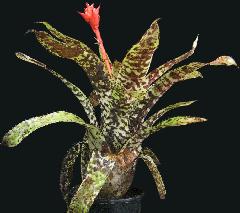
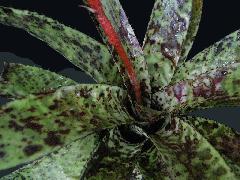
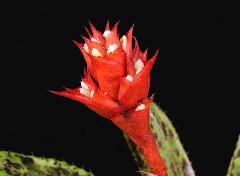
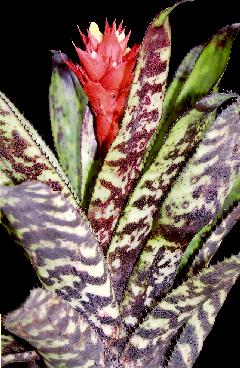
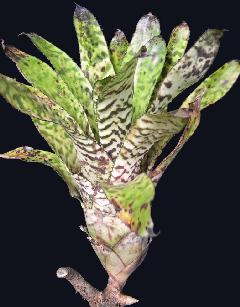
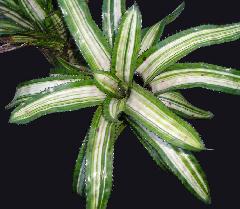
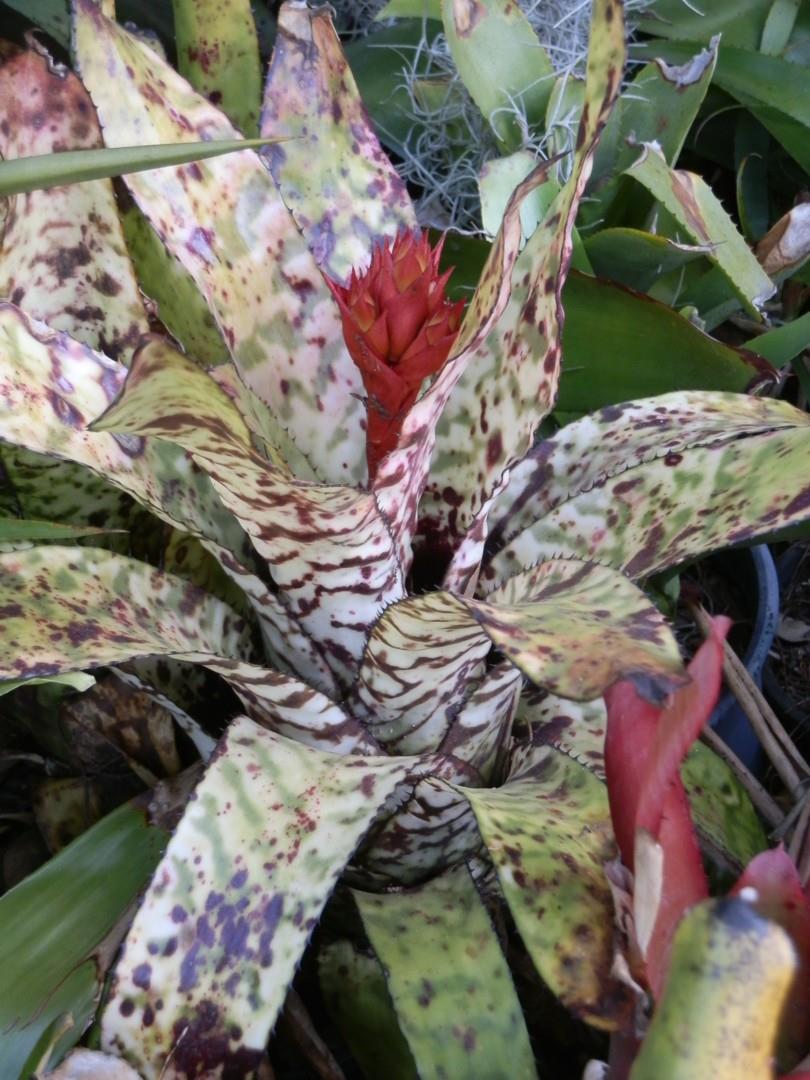
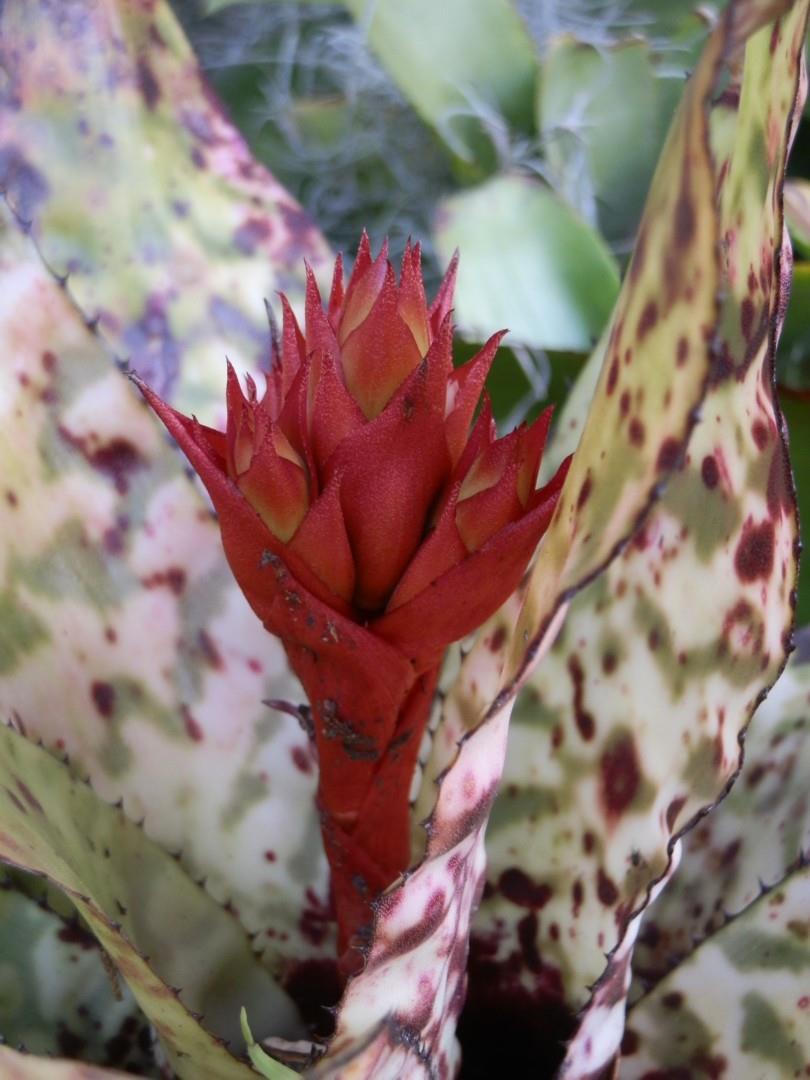

Derek Butcher's comments
In 1998 I was discussing my problem with Moyna Prince of Miami who also had A. orlandiana ss. belloi which had not been grown from seed and could be traced back to Renato Bello of Brazil. Interestingly, Moyna had sent a leaf and inflorescence to Dr. Robert Read in Naples, Florida and I quote from some of the reply.
"There is an error in Lyman Smith's monograph where it says the spikes of Aechmea orlandiana are distichous whereas in fact they are polystichous. Now to your specimen where the primary bract has very minute serrulations if at all, and the primary bracts are shorter than the spikes, whereas the description for A. orlandiana says "primary bracts like the scape-bracts, also serrulate, exceeding the spikes". The monograph also says that floral bracts ...the margins free from the rhachis whereas in fact both A. orlandiana and your plant have the floral bracts attached to the rhachis but not like in the sub-genus Platyaechmea. Further, the Monograph states that sepals are strongly asymmetric...short-mucronulate whereas in my plant of this name the sepals are strongly asymmetric to my eye, sharply mucronate. Your plant on the other hand has sepals strongly asymmetric and inconspicuously mucronulate/apiculate. A. orlandiana has broadly rounded ovate scape and primary bracts which are strongly serrate and the primary bracts exceed the spikes, while your specimen has broadly lanceolate scape and primary bracts which are minutely serrulate. This means that a corrected description of Aechmea orlandiana is needed, but I guess the lack of bars on the leaves, the open inflorescence and other minutiae would indeed allow your plant the distinction of being a distinct variety if not a natural hybrid. As Lyman always said, "It happens all the time!"
There is a small reference to Aechmea orlandiana ss belloi in the BSIJ p66 (1989) but my next main step was to obtain a copy of Bradea 4 :34. 266-7 (1986) and Jason Grant helped me in this regard. No reference was made to the difference in teeth on the scape or primary bracts, nor to the polystichous spikes of ss. belloi and distichous spikes of ss. orlandiana, nor to the strongly asymmetric sepals of ss. orlandiana. No information was given as to other Bromeliads found in the vicinity to suggest possible hybridisation. Clearly, some botanist needs to correct the formal description of Aechmea orlandiana ss. orlandiana in view of Dr Robert Read's findings so that the relationships between it and ss belloi can be properly evaluated.
Aechmea orlandiana LB Smith sub sp. belloi Pereira & Leme, Bradea 4: 266-7. 1986
Plant epiphytic, ca 40cm high, stoloniferous, stolons ca 15cm long, 10mm diam.
Leaves ca 20, rosulate, strap shaped, sub erect, forming a bell shaped utriculum at the base,
Sheath 12-16 cm long, 10-13 cm wide, wide-elliptic, or sub-orbicular, inside dark purple, with dense brown lepidote, outside green likewise dense brown lepidote.
Blade sub-linear, to narrow triangular, 20-30cm long, 5-6cm wide, tip acute and a short tail, both sides green, dense white lepidote, margins sub-dense with spines, spines ca 3mm long, 1-2mm apart, antrorse,
Scape erect, ca 30cm long, living 8mm diam., red but white towards the base, at first white lanate, then glabrous,
Scape bracts narrow- ovate, ca 5cm long, 2cm wide, spiny toward tip, whitish, inside glabrous, outside white lanate toward the base, tip acuminate, lower ones exceeding the internodes, upper ones exceeded by the internodes.
Inflorescence compound, bipinnate, sub dense, 9-11 cm long, 5cm diam., equalling the leaves or a little exceeding,
Branches ca 9, almost erect, peduncles 4-5mm long, sub-complanate, dense, elliptic, mildly complanate, 3-4.5cm long, 4-7 flowered, polystichous, bracts hiding the rachis,
Primary bracts ovate acuminate-caudate, 3-4cm long, entire, or remotely spined toward the top, orange, both sides but mainly outside, white lanate toward the base, exceeding or shorter than the branches,
Floral bracts ovate-acuminate, tip apiculate sub-pungent, 20-25mm long, 12 mm wide, membranaceous, entire, not keeled, orange, inside glabrous, outside sparse and inconspicuous white lepidote, scales long fimbriate, exceeding the sepals.
Flowers erect, sessile, 28mm long.
Sepals asymmetric, oblong, not keeled, tip mucronate, mucron 0.5mm long, curved, free or almost, glabrous, pink, 10-12mm long, 6mm wide,
Petals spathulate, tip emarginate, 20mm long, the base yellow, and white toward the tip, at the base 2 ligules, 2mm long, with acuminate lacerated top
Stamens included, Filament flattened, expanded toward the top, Series 1 free, Series 2 totally adnate to the petal, Anthers narrow-ovate, base acute, tip mucronulate, 5mm long, dorsifixed below the middle.
Ovary obovate, 7mm long, green, glabrous, Epigynous tube 2mm long, Placenta middle joined to top, Ovules many, obtuse
Type Espirito Santo, Castelo, Estrada do Corrego da Prata, ca 700msm. Leg. Elton M C Leme #699 Roberto Menescal and Roberto Bello July 1985. Holotype HB. Isotype RB
Differs from Type in
Leafblades green both sides
Inflorescence subdense
Primary bracts orange, lanate on both sides but mainly toward the base
Floral bracts orange